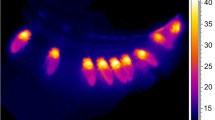Summary
Crop-filling by honeybees foraging at sources of variable nectar flow at a fixed distance from the hive has been shown to maximize energetic efficiency, defined as ratio of energy gained to energy spent. Predictions based on maximisation of rate of energy gain, defined as net energy gained per unit time foraging, are significantly different from observed behaviour (Schmid-Hempel et al. 1985). In this paper we consider the effect of varying travel times in addition to flow rate. The predictions of an extended version of our theoretical model are confronted with experimental results obtained by Núñez (1982). Núñez found that bees filled their crops more fully for higher flows and longer travel times. We show that when the cost of carrying a load is considered, this trend can be predicted by maximising either energetic efficiency or net rate of gain. Figure 1 shows, however, that maximisation of net rate of gain can only produce an acceptable quantitative fit if unreasonably high costs are assumed to result from carrying the load. Energetic efficiency instead generates a good quantitative fit for acceptable assumptions about this cost (Fig. 2).
Similar content being viewed by others
References
Boch R (1956) Die Tänze der Bienen bei nahen und fernen Trachtquellen. Z Vergl Physiol 38:136–167
Frisch K von (1965) Canzsprache und Orientierung der Bienen. Springer Berlin, Heidelberg, New York
Heran H (1962) Wie beeinflußt eine zusätzliche Last die Flugge-schwindigkeit der Honigbiene? Verh Dt Zool Ges (Wien): 346–354
Kacelnik A, Cuthill IC (1986) Starlings and optimal foraging theory: Modelling in a fractal world. In: Kamil A, Krebs JR, Pulliam RH (eds) Foraging Behavior: Plenum Press, New York (in press)
Kacelnik A, Houston AI (1984) Some effects of energy costs on foraging strategies. Anim Behav 32:609–614
Kacelnik A, Houston AI, Krebs JR (1981) Optimal foraging and territorial defence in the great tit (Parus major). Behav Ecol Sociobiol 8:35–40
McFarland DJ (1977) Decision making in animals. Nature 269:15–21
Neukirch A (1982) Dependence of the life span of the honeybee (Apis mellifera) upon flight performance and energy consumption. J Comp Physiol 146:35–40
Núñez J (1982) Honeybee foraging strategies at a food source in relation to its distance from the hive and the rate of sugar flow. J Apic Res 21:139–150
Pflumm W (1971) Zum Sammelverhalten von Wespen. Insectes Soc 18:155–160
Rothe U (1983) Stoffwechselphysiologische Untersuchungen an ruhenden, laufenden und fliegenden Honigbienen (Apis mellifera carnica). Ph. D. Thesis, Univ Saarbrücken
Schmid-Hempel P, Kacelnik A, Houston AI (1985) Honeybees maximize efficiency by not filling their crop. Behav Ecol Sociobiol 17:61–66
Schmid-Hempel P (1986) Do honey-bees get tired?. The effect of load weight on patch departure. Anim Behav (in press)
Scholze E, Pichler H, Heran H (1964) Zur Entfernungssschätzung der Bienen nach dem Kraftaufwand. Naturwissenschaften 3:69–70
Seeley TD (1985) The information-center strategy of the honeybee. In: Holldobler B, Lindauer M (eds) Experimental behavioral ecology and sociobiology. Fortschr Zool 31: 75–90
Sotavolta O (1954) On the fuel consumption of the honeybee (Apis mellifica L.) in flight experiments. Ann Zool Soc Vanamo 16:1–27
Visscher PK, Seeley TD (1982) Foraging strategy of honeybee colonies in a temperate decidous forest. Ecology 63:1790–1801
Waddington KD (1985) Cost-Intake information used in foraging. J Insect Physiol 31:891–897
Author information
Authors and Affiliations
Rights and permissions
About this article
Cite this article
Kacelnik, A., Houston, A.I. & Schmid-Hempel, P. Central-place foraging in honey bees: the effect of travel time and nectar flow on crop filling. Behav Ecol Sociobiol 19, 19–24 (1986). https://doi.org/10.1007/BF00303838
Received:
Accepted:
Issue Date:
DOI: https://doi.org/10.1007/BF00303838




